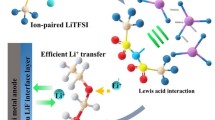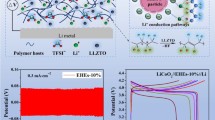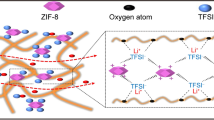Abstract
Rational composite design is highly important for the development of high-performance composite polymer electrolytes (CPEs) for solid-state lithium (Li) metal batteries. In this work, Li closo-borohydride, Li2B12H12, is introduced to poly(vinylidene fluoride)-Li-bis-(trifluoromethanesulfonyl) imide (PVDF-LiTFSI) with a bound N-methyl pyrrolidone plasticizer to form a novel CPE. This CPE shows superb Li+ conduction properties, as evidenced by its conductivity of 1.43 × 10−4 S cm−1 and Li+ transference number of 0.34 at 25°C. Density functional theory calculations reveal that Li2B12H12, which features electron-deficient multicenter bonds, can facilitate the dissociation of LiTFSI and enhance the immobilization of TFSI to improve the Li+ conduction properties of the CPE. Moreover, the fabricated CPE exhibits excellent electrochemical, thermal, and mechanical stability. The addition of Li2B12H12 can help form a protective layer at the anode/electrolyte interface, thereby preventing unwanted reactions. The above benefits of the fabricated CPE contribute to the high compatibility of the electrode. Symmetric Li cells can be stably cycled at 0.2 mA cm−2 for over 1200 h, and Li∥LiFePO4 cells can deliver a reversible specific capacity of 140 mA h g−1 after 200 cycles at 1 C at 25°C with a capacity retention of 98%.

摘要
合理的成分设计是固态锂电池用高性能复合电解质开发的重要 策略. 本文将闭式硼氢化锂Li2B12H12引入到含非游离态N-甲基吡咯烷 酮塑化剂的聚偏二氟乙烯-双三氟甲基磺酰亚胺锂(PVDF-LiTFSI)中, 制成新型复合聚合物电解质. 该电解质在25°C时具有1.43 × 10−4 S cm−1 的电导率和0.34的锂离子迁移数, 显示出优异的导锂性能. 密度泛函理 论计算表明, 具有缺电子多中心键的Li2B12H12可以促进LiTFSI的解离和 TFSI−的固定, 是锂离子导电性能改善的主要原因. 此外, 该电解质还具 有出色的电化学、热力学和机械稳定性. Li2B12H12的添加有助于在负 极/电解质界面形成保护性中间相, 阻止副反应的进一步发生. 由于上 述优势, 该电解质具有很高的电极兼容性, 如锂对称电池可以在 0.2mAcm−2下稳定循环1200多个小时, Li∥LiFePO4电池在1 C和25°C的 条件下经200个循环仍可以保持140 mA h g−1的可逆比容量, 容量保持 率为98%.
Similar content being viewed by others
References
Shi Y, Tan D, Li M, et al. Nanohybrid electrolytes for high-energy lithium-ion batteries: Recent advances and future challenges. Nanotechnology, 2019, 30: 302002
Yue L, Ma J, Zhang J, et al. All solid-state polymer electrolytes for high-performance lithium ion batteries. Energy Storage Mater, 2016, 5: 139–164
Pang Y, Pan J, Yang J, et al. Electrolyte/electrode interfaces in all-solid-state lithium batteries: A Review. Electrochem Energ Rev, 2021, 4: 169–193
Liu L, Lyu J, Mo J, et al. Flexible, high-voltage, ion-conducting composite membranes with 3D aramid nanofiber frameworks for stable all-solid-state lithium metal batteries. Sci China Mater, 2020, 63: 703–718
Huo H, Chen Y, Luo J, et al. Rational design of hierarchical “ceramic-in-polymer” and “polymer-in-ceramic” electrolytes for dendrite-free solid-state batteries. Adv Energy Mater, 2019, 9: 1804004
Meyer WH. Polymer electrolytes for lithium-ion batteries. Adv Mater, 1998, 10: 439–448
Choi SW, Kim JR, Jo SM, et al. Electrochemical and spectroscopic properties of electrospun PAN-based fibrous polymer electrolytes. J Electrochem Soc, 2005, 152: A989
Achari VB, Reddy TJR, Sharma AK, et al. Electrical, optical, and structural characterization of polymer blend (PVC/PMMA) electrolyte films. Ionics, 2007, 13: 349–354
Yao P, Zhu B, Zhai H, et al. PVDF/palygorskite nanowire composite electrolyte for 4 V rechargeable lithium batteries with high energy density. Nano Lett, 2018, 18: 6113–6120
Dirican M, Yan C, Zhu P, et al. Composite solid electrolytes for all-solid-state lithium batteries. Mater Sci Eng-R-Rep, 2019, 136: 27–46
Guo Q, Han Y, Wang H, et al. New class of LAGP-based solid polymer composite electrolyte for efficient and safe solid-state lithium batteries. ACS Appl Mater Interfaces, 2017, 9: 41837–41844
Guo X, Peng W, Wu Y, et al. Al4B2O9 nanorods-modified solid polymer electrolytes with decent integrated performance. Sci China Mater, 2020, 64: 296–306
Polu AR, Rhee HW. Effect of TiO2 nanoparticles on structural, thermal, mechanical and ionic conductivity studies of PEO12-LiTDI solid polymer electrolyte. J Industrial Eng Chem, 2016, 37: 347–353
Pitawala HMJC, Dissanayake MAKL, Seneviratne VA, et al. Effect of plasticizers (EC or PC) on the ionic conductivity and thermal properties of the (PEO)9LiTF:Al2O3 nanocomposite polymer electrolyte system. J Solid State Electrochem, 2008, 12: 783–789
Zhu LJ, Zhu LP, Zhang PB, et al. Surface zwitterionicalization of poly (vinylidene fluoride) membranes from the entrapped reactive core-shell silica nanoparticles. J Colloid Interface Sci, 2016, 468: 110–119
Li B, Su Q, Yu L, et al. Li0.35La0.55TiO3 nanofibers enhanced poly(vinylidene fluoride)-based composite polymer electrolytes for all-solid-state batteries. ACS Appl Mater Interfaces, 2019, 11: 42206–42213
Zhao Y, Yan J, Cai W, et al. Elastic and well-aligned ceramic LLZO nanofiber based electrolytes for solid-state lithium batteries. Energy Storage Mater, 2019, 23: 306–313
Shi X, Ma N, Wu Y, et al. Fabrication and electrochemical properties of LATP/PVDF composite electrolytes for rechargeable lithium-ion battery. Solid State Ion, 2018, 325: 112–119
Chen S, Zhao Y, Yang J, et al. Hybrid solid electrolytes with excellent electrochemical properties and their applications in all-solid-state cells. Ionics, 2016, 23: 2603–2611
Wu N, Chien PH, Li Y, et al. Fast Li+ conduction mechanism and interfacial chemistry of a NASICON/polymer composite electrolyte. J Am Chem Soc, 2020, 142: 2497–2505
Zhang X, Liu T, Zhang S, et al. Synergistic coupling between Li6.75La3-Zr1.75Ta0.25O12 and poly(vinylidene fluoride) induces high ionic conductivity, mechanical strength, and thermal stability of solid composite electrolytes J Am Chem Soc, 2017, 139: 13779–13785
Yang L, Wang Z, Feng Y, et al. Flexible composite solid electrolyte facilitating highly stable “soft contacting” Li-electrolyte interface for solid state lithium-ion batteries Adv Energy Mater, 2017, 7: 1701437
Pan K, Zhang L, Qian W, et al. A flexible ceramic/polymer hybrid solid electrolyte for solid-state lithium metal batteries Adv Mater, 2020, 32: 2000399
Pang Y, Wang X, Shi X, et al. Solid-state prelithiation enables high-performance Li-Al-H anode for solid-state batteries Adv Energy Mater, 2020, 10: 1902795
Paskevicius M, Jepsen LH, Schouwink P, et al. Metal borohydrides and derivatives—Synthesis, structure and properties. Chem Soc Rev, 2017, 46: 1565–1634
Lu Z, Ciucci F Metal borohydrides as electrolytes for solid-state Li, Na, Mg, and Ca batteries: A first-principles study Chem Mater, 2017, 29: 9308–9319
Cuan J, Zhou Y, Zhou T, et al. Borohydride-scaffolded Li/Na/Mg fast ionic conductors for promising solid-state electrolytes Adv Mater, 2019, 31: 1803533
Lu F, Pang Y, Zhu M, et al. A high-performance Li-B-H electrolyte for all-solid-state Li batteries Adv Funct Mater, 2019, 29: 1809219
Teprovich JA, Colón-Mercado H, Washington II AL, et al. Bi-functional Li2B12H12 for energy storage and conversion applications: Solid-state electrolyte and luminescent down-conversion dye. J Mater Chem A, 2015, 3: 22853–22859
Shi X, Pang Y, Wang B, et al. In situ forming LiF nanodecorated electrolyte/electrode interfaces for stable all-solid-state batteries Mater Today Nano, 2020, 10: 100079
Li S, Ju X, Wan C First-principles calculations of structural, elastic and electronic properties of Li2B12H12. J Alloys Compd, 2014, 593: 169–175
Pitt MP, Paskevicius M, Brown DH, et al. Thermal stability of Li2B12H12 and its role in the decomposition of LiBH4. J Am Chem Soc, 2013, 135: 6930–6941
Kresse G, Furthmüller J. Efficient iterative schemes for ab initio total-energy calculations using a plane-wave basis set. Phys Rev B, 1996, 54: 11169–11186
Vanderbilt D. Soft self-consistent pseudopotentials in a generalized eigenvalue formalism. Phys Rev B, 1990, 41: 7892–7895
Perdew JP, Zunger A. Self-interaction correction to density-functional approximations for many-electron systems. Phys Rev B, 1981, 23: 5048–5079
Perdew JP, Burke K, Ernzerhof M. Generalized gradient approximation made simple. Phys Rev Lett, 1996, 77: 3865–3868
Dion M, Rydberg H, Schröder E, et al. Van der Waals density functional for general geometries. Phys Rev Lett, 2004, 92: 246401
Sun Y, Zhan X, Hu J, et al. Improving ionic conductivity with bimodal-sized Li7La3Zr2O12 fillers for composite polymer electrolytes. ACS Appl Mater Interfaces, 2019, 11: 12467–12475
Muetterties EL, Merrifield RE, Miller HC, et al. Chemistry of boranes. III. 1 the infrared and Raman spectra of B12H12− and related anions. J Am Chem Soc, 1962, 84: 2506–2508
Bag S, Zhou C, Kim PJ, et al. LiF modified stable flexible PVDF-garnet hybrid electrolyte for high performance all-solid-state Li-S batteries. Energy Storage Mater, 2020, 24: 198–207
Zhao Y, Wu C, Peng G, et al. A new solid polymer electrolyte incorporating Li10GeP2S12 into a polyethylene oxide matrix for all-solid-state lithium batteries. J Power Sources, 2016, 301: 47–53
Li Y, Arnold W, Thapa A, et al. Stable and flexible sulfide composite electrolyte for high-performance solid-state lithium batteries. ACS Appl Mater Interfaces, 2020, 12: 42653–42659
Bruce P. Conductivity and transference number measurements on polymer electrolytes. Solid State Ion, 1988, 28–30: 918–922
Bruce PG, Vincent CA. Steady state current flow in solid binary electrolyte cells. J Electroanal Chem Interfacial Electrochem, 1987, 225: 1–17
Ohba N, Miwa K, Aoki M, et al. First-principles study on the stability of intermediate compounds of LiBH4. Phys Rev B, 2006, 74: 075110
Verdal N, Her JH, Stavila V, et al. Complex high-temperature phase transitions in Li2B12H12 and Na2B12H12. J Solid State Chem, 2014, 212: 81–91
Chen H, Adekoya D, Hencz L, et al. Stable seamless interfaces and rapid ionic conductivity of Ca-CeO2/LiTFSI/PEO composite electrolyte for high-rate and high-voltage all-solid-state battery. Adv Energy Mater, 2020, 10: 2000049
Xu H, Chien PH, Shi J, et al. High-performance all-solid-state batteries enabled by salt bonding to perovskite in poly(ethylene oxide). Proc Natl Acad Sci USA, 2019, 116: 18815–18821
Zhu M, Pang Y, Lu F, et al. In situ formed Li-B-H complex with high Li-ion conductivity as a potential solid electrolyte for Li batteries. ACS Appl Mater Interfaces, 2019, 11: 14136–14141
Callegari D, Bonizzoni S, Berbenni V, et al. Is it possible to obtain solvent-free, Li+-conducting solid electrolytes based on pure PVDF? Comment on “self-suppression of lithium dendrite in all-solid-state lithium metal batteries with poly(vinylidene difluoride)-based solid electrolytes”. Adv Mater, 2020, 32: 1907375
Zhang X, Wang S, Xue C, et al. Response to comment on “self-suppression of lithium dendrite in all-solid-state lithium metal batteries with poly(vinylidene difluoride)-based solid electrolytes”. Adv Mater, 2020, 32: 2000026
Lin Y, Gao MX, Zhu D, et al. Effects of carbon coating and iron phosphides on the electrochemical properties of LiFePO4/C. J Power Sources, 2008, 184: 444–448
Acknowledgements
This work was supported by the National Natural Science Foundation of China (51971146 and 51971147), the Major Program for the Scientific Research Innovation Plan of Shanghai Education Commission (2019-01-07-00-07-E00015), Shanghai Outstanding Academic Leaders Plan, Guangxi Key Laboratory of Information Materials (Guilin University of Electronic Technology, 201017-K), Shanghai Rising-Star Program (20QA1407100), and the General Program of Natural Science Foundation of Shanghai (20ZR1438400).
Author information
Authors and Affiliations
Contributions
Pang Y and Zheng S proposed the idea; Bao K conducted the experiments; Bao K and Fang F performed the data analysis; Bao K and Pang Y wrote the paper with support from Yang J and Zheng S; Pang Y and Sun D contributed to the theoretical analysis. All authors contributed to the general discussion.
Corresponding authors
Additional information
Kepan Bao received his BS degree from the School of Energy and Environmental Engineering at the University of Science and Technology Beijing in 2018. Currently, he is an MS student at the School of Materials Science and Engineering, University of Shanghai for Science and Technology. His research focuses on composite solid electrolytes for solid-state batteries.
Yuepeng Pang received his PhD degree from the Department of Materials Science and Engineering at Zhejiang University in 2014. He is currently an associate professor at the School of Materials Science and Engineering, University of Shanghai for Science and Technology. His current research mainly focuses on hydride materials for solid-state batteries.
Fang Fang received his PhD degree from the Department of Materials Science at Fudan University in 2009. He is currently a professor at the Department of Materials Science, Fudan University. His current research interests focus on high-performance hydrogen storage materials and key materials for solid-state batteries.
Shiyou Zheng received his BS, MS, and PhD degrees from Sichuan University, Zhejiang University, and Fudan University, respectively. He became a visiting researcher at the National Institute of Standards and Technology and the University of Maryland and is currently a professor at the University of Shanghai for Science and Technology. His research interests include new energy materials for batteries, supercapacitors, and hydrogen storage. He was selected as a “Young and Middle-aged Experts with Outstanding Experts” by the New Century Talents Project in 2019.
Conflict of interest
The authors declare that they have no conflict of interest.
Supporting Information
40843_2021_1740_MOESM1_ESM.pdf
Modulating composite polymer electrolyte by lithium closo-borohydride achieves highly stable solid-state battery at 25°C
Rights and permissions
About this article
Cite this article
Bao, K., Pang, Y., Yang, J. et al. Modulating composite polymer electrolyte by lithium closo-borohydride achieves highly stable solid-state battery at 25°C. Sci. China Mater. 65, 95–104 (2022). https://doi.org/10.1007/s40843-021-1740-7
Received:
Accepted:
Published:
Issue Date:
DOI: https://doi.org/10.1007/s40843-021-1740-7




